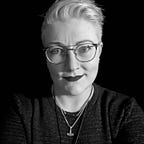The Against List
A little over three years ago, we published The With List, a self-reflection exercise for designers beginning to engage with disability.
Over the past three years, a lot has obviously changed in the world, and a lot has changed in the work we do at The Disabled List as well.
We have realized that whereas “with” was originally meant to signal a commitment to supporting and uplifting disabled people within design spaces, it has become coopted as a branding exercise that protects companies from critiques of their so-called inclusive design.
We have realized that advocating for “more disabled people in design” without advocating structural changes to what design is, how it operates, and what problems it seeks to solve is just advocating for a select few people to gain more power within an unjust system, while allowing the marginalization of others by that system to become more entrenched.
We have realized that it is not enough to “design for” ideal outcomes or marginalized user groups; we must design against systems that warp and recuperate those outcomes, and that inflict violence on those user groups. We must name the authors of the problems we claim to want to solve.
To that end, we have created a new list of self-reflection questions for designers that reflects our evolving thinking about design and disability. The first set of questions are general in focus; they are for any designers to reflect on, whether or not they have yet done work with disabled people and communities. The second set of questions are for designers who have already worked, or are currently working, with disabled people and communities. The final section asks designers to critically reflect on certain ways of thinking that shape how disability-engaged design is done.
In the interest of citational justice, we have not arrived at these ideas on our own. We have been shaped and supported by other incredible designers and scholars doing critical work at the intersection of design, disability and race, including (and very much not limited to) George Aye, Jennifer Rittner and Rua Mae Williams.
Like the WITH List, this exercise is meant to be a starting point for an ongoing process — just like any kind of learning. It is also not meant to be comfortable. Meaningful allyship means challenging a status quo that has benefited you, but which harms marginalized people and communities. That in turn means interrogating how you have benefitted from that status quo, and perhaps reinforced it, and how you can use the relative power that you have to disrupt it instead. And that means being willing to get uncomfortable, and to sit with that discomfort.
We recommend that you print or write out the questions, or copy them into a text document, and record your answers. This way you can keep track of how your ideas develop over time.
Yours in friction,
Liz and Alex
****
Section 1
- What is disability?
- How did I arrive at this definition?
- What does not “count as disability? Why not?
- What are some things I know about disabled people and their experiences? Where did I learn these things?
- How do I feel about engaging with disabled people and communities in my work?
- What, if anything, is my relationship to disability? What assumptions might I bring to disability-engaged design work because of this?
- How might having a medical diagnosis, or not having one, affect the way a disabled person experiences the world? How might it affect their relationship to disability-engaged design? How might it affect their needs as users of what I design?
****
Section 2
- Who are the disabled users I have worked with and how were they recruited?
- How do we categorize disability in our recruitment screeners and how do those categories relate to the user experiences we are researching?
- Who are the disabled people who are getting left out by our recruitment practices?
- What is my role as a designer whose work involves disabled people and communities? How do I feel about that role?
- Who are all the people and organizations benefiting from this work and how are they benefitting?
- Who am I hoping to impress with this work?
- How will the accessibility of this project be maintained and sustained after it has been announced?
****
Section 3
- The Charity Model is one way of thinking about disability. It says that disabled people are disadvantaged and in need of help. Under this model, good citizens feel pity for disabled people or inspired by their struggle, and these feelings motivate them to “help” in ways that risk undermining disabled people’s autonomy. What are some ways that the Charity Model show up in disability-engaged design spaces?
- What are some ways you could challenge those dynamics when you encounter them in your own work?
- Can you think of any design projects that have ended up harming a marginalized community they were meant to help? Has this happened with any of your own projects?
- How would you recognize if a project you are working on is becoming harmful? What would you do about that?
